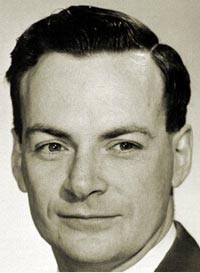
| Born: May 11, 1918 in Manhattan, New York |
| Died: Feb 15, 1988 (at age 69) in Los Angeles, California |
| Nationality: American |
| Famous For: Acoustic wave equation, Bethe–Feynman formula, Feynman checkerboard, Feynman diagrams, Feynman gauge, Feynman–Kac formula, Feynman Long Division Puzzles, Feynman parametrization, and many others |
| Awards: Albert Einstein Award (1954), E. O. Lawrence Award (1962), Nobel Prize in Physics (1965), Oersted Medal (1972) and National Medal of Science (1979) |
Richard was a theoretical physicist who made major contribution in physics. He was born on May 11th, 1918 in Manhattan, New York, United States. He studied at the renowned Massachusetts Institute of Technology where he obtained his Bachelor of Science in 1939. From an early age he was influenced by his father to challenge orthodox thinking and this contributed to his love for the study of Physics.
Education
Richard attended the Far Rockaway High School. When he was 15, he taught himself advanced algebra, trigonometry, analytic geometry, infinite series, as well as integral and differential calculus. Before joining college, he was already recreating mathematical models and experimenting with them. He won the New York Math Championship in his last year in high school. After studying at the Massachusetts Institute of Technology he went on to learn more at Princeton University.
Contributions and Academic Career
After completing his PhD in 1942, Richard became an assistant physics professor at the University of Wisconsin-Madison. After the WWII and his participation in the Manhattan Project, he joined Cornell University where he taught physics in the period from 1945 to 1950. In his later years, he joined the California Institute of Technology as a professor due to his love for teaching. Throughout his academic career, he gained the reputation of being a “great explainer” due to his ability to clarify complex concepts in a simple way.
The Manhattan Project
Richard Feynman participated in the Manhattan project while at Princeton. This was the U.S. wartime project involving the development of the atomic bomb. Though he was a junior physicist, and was therefore not central to the project, his input was immense as he was made a group leader. His main task was in the theoretical division where he led the computation group in the human computers division. He also calculated neutron equations for a small reactor in the project in order to measure how close to criticality an assembly of fissile material was.
Quantum Electrodynamics
This is the theory for which he won the Nobel Prize due to its accurate predictions. He started working on the theory as an undergraduate and advanced it in his later years at Cornell. His work under this theory consisted of two distinct formulations. The first one was his Path Integral Formulation and the second was his formulation of the Feynman Diagrams.
Weak Decay Model
Richard developed a weak decay model which showed that the current coupling in the decay process is a combination of axial and vector currents. Though his theory was developed around the same time as that of Robert Marshak and E. C. George Sudarshan, his theory was seminal as it neatly explained the weak interaction by the axial and vector currents. Together with the 1933 beta decay theory, the combination of the two theories explained parity violation.
Super-fluidity of Super-Cooled Liquid Helium
Richard came up with a quantum-mechanical explanation for this observation of helium as it displays a total lack of viscosity when flowing. He applied the Schrodinger equation which showed that helium was displaying a quantum mechanical behavior which is observable to the naked eye.
Richard Feynman passed away February 15th, 1988 at the age of 69 leaving behind an incredible legacy in physics.